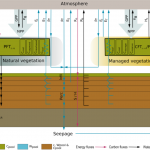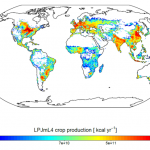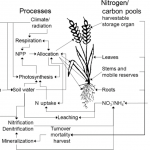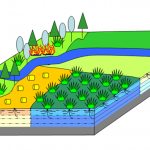LPJmL
Larger development team at PIK and partner institutes (Potsdam Institute for Climate Impact Research)
Overview
| Model category | FSPM, CSM |
|---|---|
| Plant part | Whole_plant |
| Scale | Whole_plant, Field, Regional, Global |
| Licence | open_source |
| Operating system | Any |
| Programming language | C |
| Format of model inputs and outputs | netcdf of tailor-made format |
| Species studied | Perennial-and-annual-plants, Soybean, Wheat |
| Execution environment | Console |
Scientific article
LPJmL4 – a dynamic global vegetation model with managed land – Part 1: Model descriptionSibyll Schaphoff,Werner von Bloh,Anja Rammig,Kirsten Thonicke,Hester Biemans,Matthias Forkel,Dieter Gerten,Jens Heinke,Jonas Jägermeyr,Jürgen Knauer,Fanny Langerwisch,Wolfgang Lucht,Christoph Müller,Susanne Rolinski,and Katharina WahaGeoscientific Model Development, 2018 View paper
Model description
LPJmL is a dynamic global vegetation, hydrology and crop model, coupling the carbon-, water-, and nitrogen cycles at the plant and soil level. It is based on a generalized Farquhar photosynthesis scheme and stomatal conductance mechanics, functional and allometric rules and can simulate managed and natural ecosystems in given land-use configurations as well as the biogeochemical fluxes between these.
Some case studies
Some studies using LPJmL:
- D. Gerten et al., « Asynchronous exposure to global warming: freshwater resources and terrestrial ecosystems », Environ. Res. Lett., vol. 8, no 3, p. 034032, sept. 2013.
- B. Schauberger, S. Rolinski, S. Schaphoff, et C. Müller, « Global historical soybean and wheat yield loss estimates from ozone pollution considering water and temperature as modifying effects », Agricultural and Forest Meteorology, vol. 265, p. 1‑15, févr. 2019.
- W. von Bloh, S. Schaphoff, C. Müller, S. Rolinski, K. Waha, et S. Zaehle, « Implementing the nitrogen cycle into the dynamic global vegetation, hydrology, and crop growth model LPJmL (version 5.0) », Geosci. Model Dev., vol. 11, no 7, p. 2789‑2812, juill. 2018.



